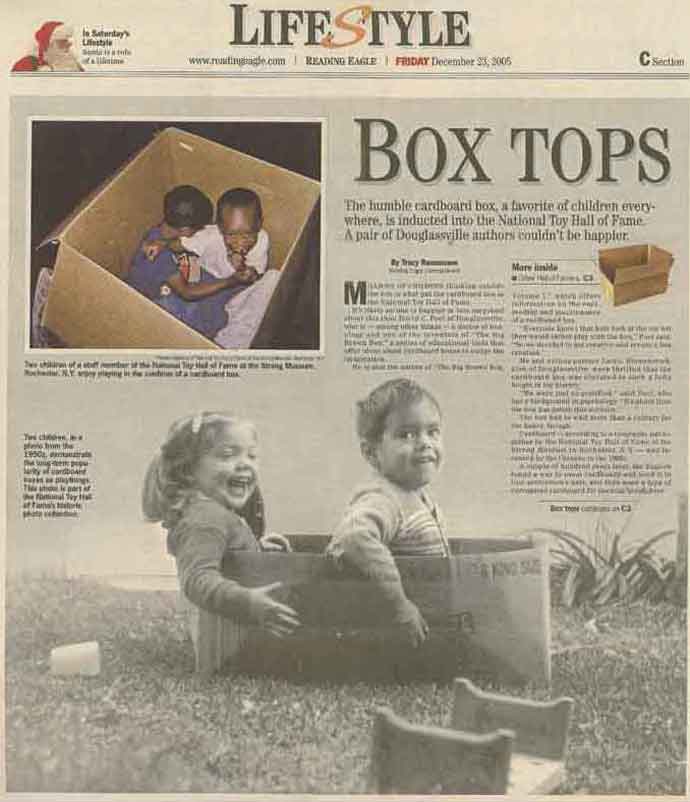READING EAGLE LIFESTYLES 12-23-2005


Captions for photos
(top to bottom):
Two children of a staff member of the National Toy Hall of Fame at the Strong Museum, Rochester, N.Y. enjoy playing in the confines of a cardboard box.
Two childre, in a photo from the 1950's, demonstrate the long-term popularity of cardboard boxes as playthings. This photo is part of the National Toy Hall of Fame's historic photo collection.
A child discovers the joys of playing in a cardboard box in this photo which is part of a collection at the National Toy Hall of Fame at the Strong Museum, Rochester, N.Y.
Click here to return to Media Page
BOX TOPS
The humble cardboard box, a favorite of children everywhere, is inducted into the National Toy Hall of Fame. A Pair of Douglassville authors couldn't be happier.
By Tracy Rasmussen
Reading Eagle correspondent
Millions of children thinking outside the box is what put the cardboard box in the National Toy Hall of Fame.
It's likely no one is happier or less surprised about this than David C. Pool of Douglassville, who is -- among other things -- a doctor of boxology and one of the inventors of "The Big Brown Box," a series of educational tools that offer ideas about cardboard boxes to nudge the imagination.
He is also the author of "The Big Brown Box, Volume 1," which offers information on the care, feeding and maintenance of a cardboard box.
"Everyone knows that kids look at the toy but they would rather play with the box," Pool said. "So we decided to get creative and create a box creation."
He and writing partner Jackie Blumenstock, also of Douglassville, were thrilled that the cardboard box was elevated to such a lofty height in toy history.
"We were just so gratified," said Pool, who has a background in psychology. "It's about time the box has gotten this acclaim.
"The box had to wait more than a century for the honor, though.
Cardboard -- according to a biography put together by the National Toy Hall of Fame at the Strong Museum in Rochester, N.Y. -- was invented by the Chinese in the late 1600's.
A couple of hundred years later, the English found a way to pleat cardboard and used it to line gentlemen's hats, and then used a type of corrugated cardboard for packing breakables.
Folded into a shape
In 1879 American Robert Gair went one better on both the Chinese and the English and invented a box that could lay flat and then be easily folded into a shape that could be used to store things.
The lives of children were instantly changed as they had an inexpensive way to build forts and cars and spaceships and just about anything they could imagine.
And imagination is what the cardboard box is all about.
"You put a box down and kids go crazy," Blumenstock said. "My own kids went crazy, so I started thinking about other uses for cardboard boxes."
"Parents will tell you that they don't even know why they spend money on the toys, when it's the boxes that the kids go for," Pool said. "It's one of the few times that play isn't programmed at all".
"What came from that brainstorming was the Browny Big Box adventure series of books (the first book in the series is "Making New Friends," about moving - and if ever there was a mother lode of cardboard boxes, it's after a move!) and the Big Brown Box Web site, www.thebigbrownbox.com.
Blumenstock is quick to point out that while the whole point of the box is to stimulate imagination, the books and suggestions on the Web site are just prompts to get kids thinking and creating on their own.
"It's really meant to enhance a child's imagination," she said. "They're in control of whatever comes out of the box."
Boxes a hit
Robin Henschel of Funtoysia in West Reading carries the Big Brown Box items in her store, and with 21 years in the toy sales business, she agrees that sometimes kids just like the boxes better than the toys in them.
"Parents say all the time that the kids prefer the boxes," she said. "Because they're fun; you can crawl into them, or use them for all kinds of things."
So buying toys that come in big boxes is actually like getting two presents for the price of one.
"Everyone has a fun memory about a box," Blumenstock said. "Some kids may have turned a box into a fort, or someone else may have taken it outside and used it to slide down a big hill. I talked to someone once who told me that he built the best time capsule out of a box. They're just great."
She suggested handing a child a box of crayons and a medium size box and seeing what he or she comes up with.
"And in the summertime, you can go outside and do the same thing with paint," she said. "It will really keep them occupied."
The best part for parents though, is that it's cheap entertainment. "If the kids end up destroying it," Blumenstock said, "you can just go get another one."
But will fame change the humble cardboard box?
Blumenstock said she believes the cardboard box will maintain its low-profile image and continue its mission of cheap and imaginative play.
"We're just so thrilled this happened," she said. "It really just validates what we've been saying all along."
- Contact correspondent Tracy Rasmussen at Lifestyle@readingeagle.com .
return to Top of Page